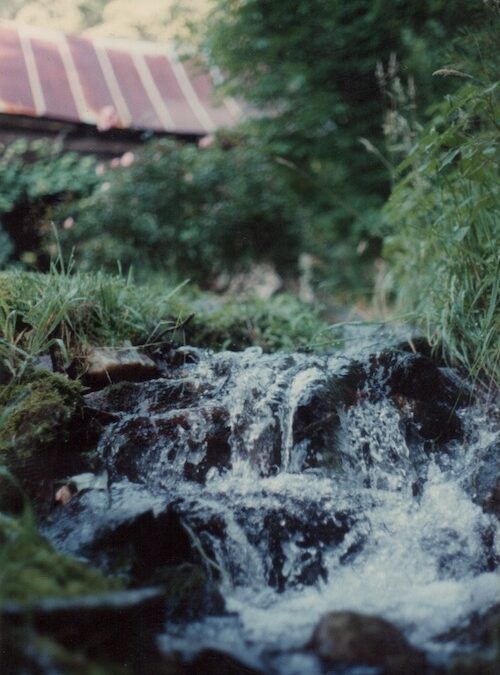In years past, when privileged to eat out or when visiting friends I’ve often been asked “What would you like to drink?”—to which I’d usually answer, “Water, please”—thinking the tap would be used to accommodate my humble reply. When asked this at friend’s homes my answer was out of politeness in an effort to not trouble them for a canned soda; in the case of eating out…simply because I’m a cheapskate. In recent years, however, things have changed. I’m now frequently handed a bought, sealed, plastic bottle of water in both situations—warding off my modest attempts to be an economical guest or a cheap customer (the restaurant charges me as much for a bottle of water as they would have for some good sweet tea, which I would have rather had). These days I almost feel like a pioneer myself, just getting a drink of water from the faucet. In another generation or so, young folks will never believe we ever drank from the pipes in our homes. It’ll probably get the same reaction as dipping a drinking glass in the tank of your toilet would today (which I’ve never done or desired to do, please believe me).
I’ll admit, though, that water coming out of a faucet in my kitchen never looks as satisfying as a babbling little creek like this one to the left does. I get thirsty just lookin’ at it; very tempting to cup your hands and get a quick drink if you’re blessed enough to discover one, being hot and thirsty in the woods. However, it may not necessarily be the best idea unless your physical constitution is strong, or you have some water purification tablets, or one of those filter gadgets. Most of the natural water sources immediately around us just aren’t that clean anymore. So what happened? How did our pioneer fathers and mothers find a drink, not having filters, tablets, or modern plumbing in their homes?
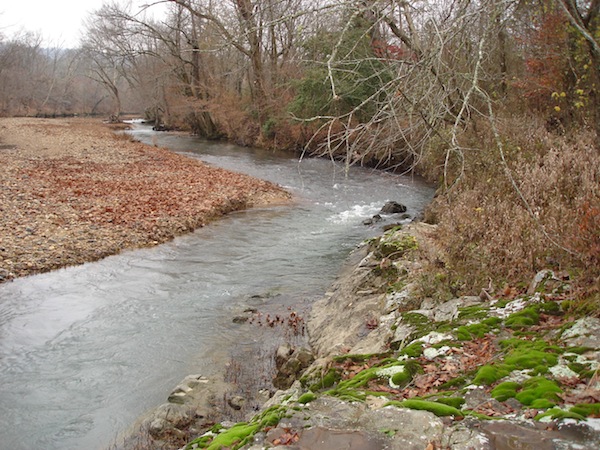
Creeks & Rivers
At the time of America’s southern and mid-western settlement in the 1800’s it didn’t used to be so hard to find a good drink from a non-stagnate, running water source like a creek or river that didn’t send you runnin’ to the woods or outhouse in half an hour. So why was water much cleaner then than now? The reason was pretty simple: Not that many people or livestock upstream to contaminate water sources…and that was just about anywhere you found yourself.
So with regard to that fact you can imagine that picking your homestead site near a good river or creek was of utmost importance. Streams and rivers that nowadays are somewhat muddy were generally clear back then, and a little deeper. Then with the populating of rural areas as more land was turned over for planting, more dirt and silt washed out of the fields and into creeks and rivers. This is why riverboats could travel far upriver in many places that they’d have trouble paddling today. But it was harmful bacteria—not mud—that was and is the culprit for unhealthy drinking water. Consider the fact that as more and more land near creeks and rivers (this is where the best, fertile, flat soil for cultivation existed) was put to agriculture, there was less of a filtering system of grass, brush, and trees to slow down the runoff with all that it contained. Now don’t get me wrong; bacteria were always present in water sources to some degree. Some folks got sick back then, too. Cholera and typhoid was once a serious problem, but again, often happening in the more heavily populated areas.

These days in the more agricultural areas it’s hard to find a stream or river that’s not very muddy most of the time.
Springs
Obviously rivers or creeks weren’t necessarily near every good plot of farmland a farmer might choose for his homestead. In that instance a farmer would be delighted to find a spring, if not on his property, at least within walking distance. A good “bold” (generously flowing, good tasting) spring was something to be proud of1. These usually dictated to him about where his house or cabin might stand. Who wants to walk too far for a drink? But if it was some distance away, most anecdotes suggest it usually became the job of the youngest child in the family.

This spring, flows out from a hillside not far from my property. The stone masonry lining for the basin is still in good shape, and may have provided the footing for a springhouse at one time.
A spring forms when the water table (or water bearing formation also called an aquifer) meets ground level. That’s basically it. There are a few different types of springs, being defined by the various ways the water table naturally flows to the surface where it can be seen or utilized. Of those types are a few notable ones:
Seepage springs occur when the water table hits ground level in a low spot, but doesn’t really go anywhere. These were good to avoid when it came to a drink since it’s hard for them to cleanse themselves of things that might also happen to find their way to low spots (things you probably wouldn’t want to put in your mouth).
Intermittent springs are supplied by seasonal precipitation, and may run dry during spells of drought. These also might not be as clean as water coming from deeper layers that act as filters in spring types like the…
…gravity spring. This type was and is perhaps the most commonly used. In a gravity spring, the water table is not allowed to go deeper due to some impervious layer beneath it (rock or clay), but comes out of the ground on either the side of a hill or cliff, and then runs down a channel. Rivers come from creeks, and many creeks begin as gravity springs.
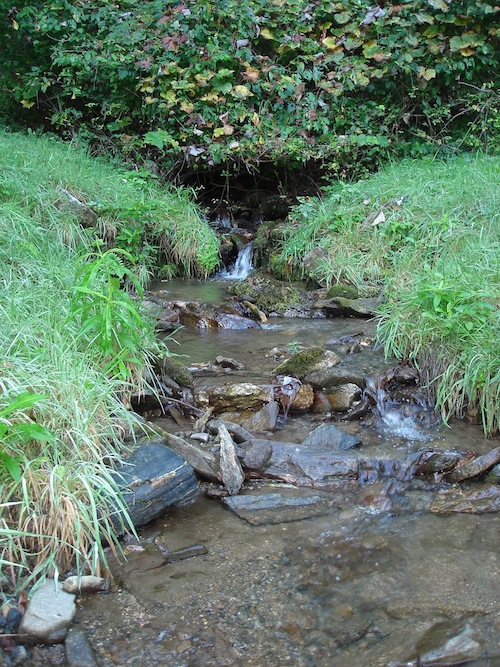
A spring-fed creek, way up in the mountains of North Carolina
Even though these were naturally occurring geological formations, it didn’t stop settlers from improving on nature’s design by enlarging and deepening the basin (catching area) of a spring, by lining it with rocks and building up the height to make it deeper. Along with dipping water out for various needs, the temperature of the cool spring was also made handy. Crocks of milk or buttermilk could be sat down in the basin area keeping them as cool as the water that flowed out of the ground (around 55 degrees). To keep animals out, a small springhouse was sometimes built directly over this natural outlet of water.
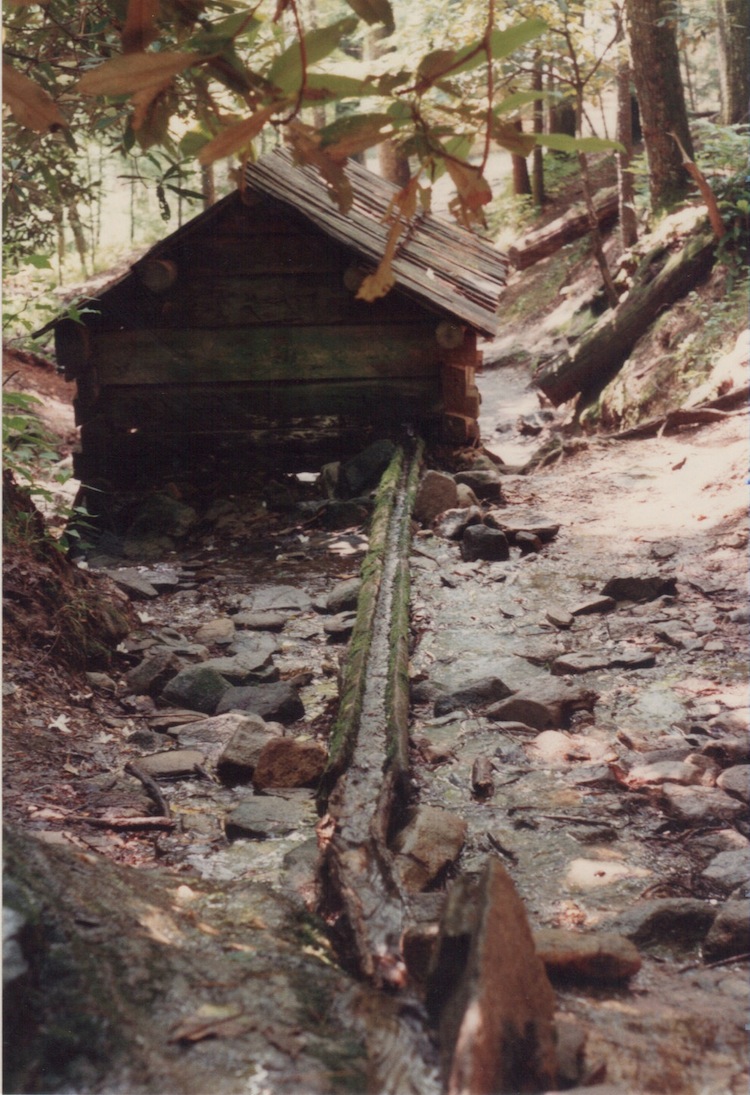
This springhouse in Cades Cove, Tennessee is fed by a spring that passes underneath, but utilizes a small log gutter that elevates the water, dropping it into a wooden trough inside
If for some reason there was no room to construct a springhouse directly on top, it could be located down the hill having the overflow from the spring passing underneath the structure. If this was still not adequate and there was enough of a drop in the downward hillside, the flow from the spring could be rerouted a few feet away to a more suitable location through troughs or half a hollowed log. The “tap” of water rerouted through the trough might drip into a wooden box and then out again to an outlet where it would eventually run back into the downward channel of the spring. Sometimes the wooden box (normally oak), which had its cool water replenished 24 hours a day, was also used to hold food or milk (in jars or crocks) keeping it cool as the continuously fresh water flowed around it. In the warmer months less perishable food was also stored on shelves or hung from the rafters in the damp and cool springhouse. This setup and variations of it were typically found in the extreme grades and hilly land of the Appalachians or the Ozarks. [Note: I want to emphasize the word “variations”; people took advantage of the uniqueness of each spring’s characteristics and used their imaginations and resources to make the most of their situation]
Depending on the lay of the ground between the spring and the home, water could even be diverted all the way to the cabin or house itself, and made to run into the kitchen sink! These were sometimes routed by virtue of homemade, wooden pipes. Drilled with a long auger made for just this purpose, these pipes were sharpened to a conical point on one end that would be fit into the receiving end of the next pipe. Now that’s runnin’ water! In such instances of indoor “running water” the only consideration was where to route the continuous overflow; but that’s a problem I would’ve loved to have had. You would have never gotten on to the kids about leaving the faucet running, and the dog or chickens would’ve always had a fresh drink on the downhill side of the house.
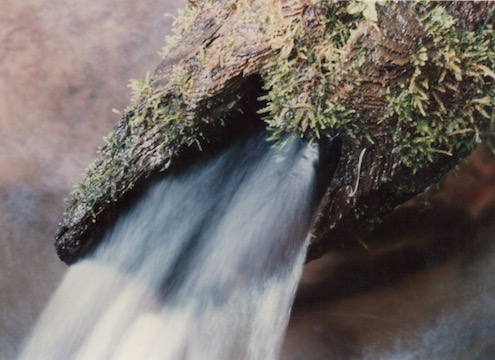
The cone-shaped end of an old, hand-drilled water pipe, now used as decoration and amusement near an old footbridge in the Smokies.
Artesian Wells
In flatter areas of the country, artesian wells (also known as overflowing wells) were perhaps the most ideal of all water situations. There probably weren’t as many of these utilized until the 1900’s. If you had one, you were indeed a blessed individual. An artesian well’s existence requires a specific geological anomaly to make it work: It’s basically an aquifer confined by an impermeable strata like rock or clay, and set in such a way that the shape of the aquifer itself bends upward or uphill at some point. If a well is drilled into this confined water table, at a point that is below the upper most part of the water table, the pressure of the water’s weight causes the well to flow continuously in its effort to relieve the pressure…without any external pumping required. Later, some time after the turn of the century these wells were occasionally capped off with pipes sticking out of the ground making it easy to catch water in containers. There are also artesian springs, in which this unique occurrence of underground water under pressure rises to the ground level on it’s own, due to the pressure put on it by the water table that extends above the point of exit.
Rainwater & Cisterns
The easiest way to find water is if it’s raining: Stand out in the rain with your head up and your mouth open.
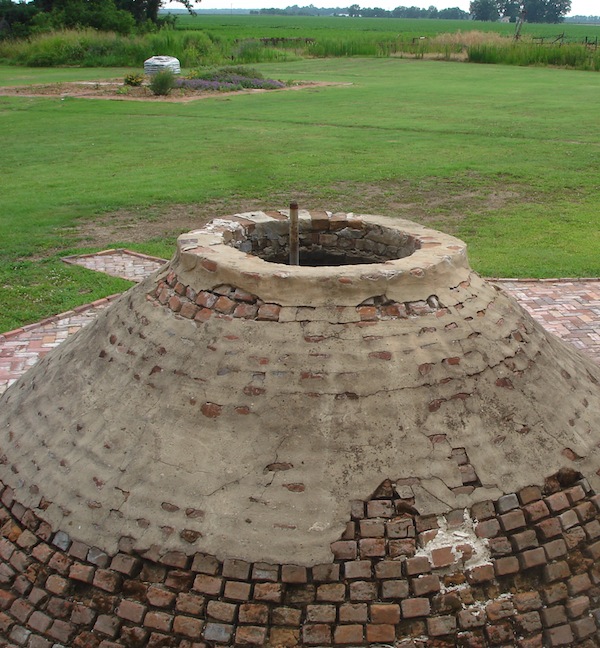
This cistern located at the historic Lakeport Plantation house on the Mississippi River in Chicot County, Arkansas is a nice big one, and fairly rare. It’s fed by a large roof gutter system into underground channels that surround the house and empty into the deep dome structure pictured here.
I’d like to point out that the use of a container saves time. It’s probably not even necessary to point out that our water was most conveniently caught (by generations past) as it ran off the roof of a homesteader’s home into a bucket, barrel, or whatever was handy. It saved a walk to the spring or creek.
Cisterns were an upgrade on this principle, improving the quantities of water caught, but not necessarily the quality. It’s basically underground storage of caught rainwater, usually from the roof of a home through a wooden channel or V-shaped trough—and covered or protected from animal contamination or falling children however possible. The upside was you didn’t have to dig as deep as a well, and it was as accessible to the house as you could make it (occasionally even under the porch). The downside was the potential for the water to stagnate or become contaminated. For this reason the water from these was generally used for washing clothes, cleaning, bathing, or giving livestock a drink.
A cistern was often dug down several feet, with the sides probably being rubbed smooth while wet. Later on, store-bought metal pumps like the ones we see Michael Landon (a.k.a. Charles Ingalls) or Chuck O’Connors (a.k.a. “The Rifleman”) pumping on could be obtained and installed to retrieve cistern water more conveniently.
Dug Wells
Even with springs within walking distance, I can imagine the farm wife continually reminding her husband of the neighbors down the road who dug a well right next to their home. Very convenient on wash day, she must have thought.
But dangerous to build. Much could go wrong, and badly at that.
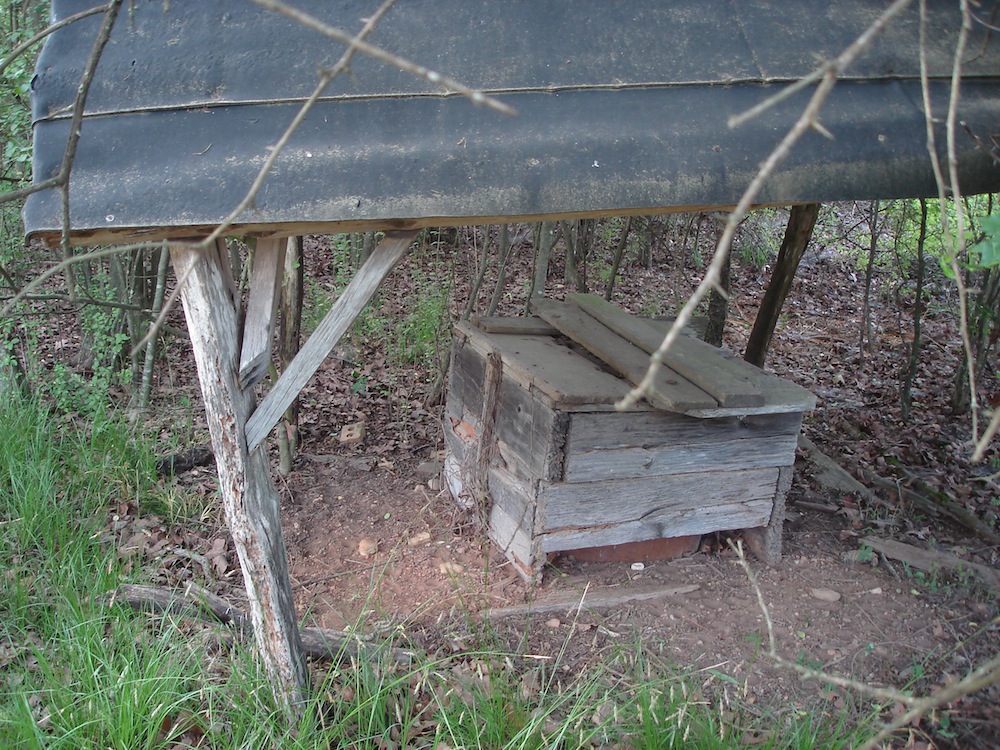
An abandoned well on my Great Uncle Virgil’s homeplace
Well diggin’ back then usually began with a wagon wheel tire (a large metal band forming a ring about 4 feet in diameter) place on the ground to show where to dig the perfect circle. That’s the easy part. After that comes the muscle. We’re talking about 20 to 30 foot down often (occasionally maybe even up to 50 or more but it makes me tired thinking about it), and barely enough room to use a pick or shovel that’s handle was cut in half. All the dirt had to be hoisted up in a bucket, and probably not a big one. The windlass used to haul up the bucket and dirt is also the one used to get the digger himself down and up. It needed to be strong, but so did the rope…and the men winding it.
Cave-ins from the ground above you. Another consideration. I think we all get that picture. But then there’s the risks of cave-ins below you. I had a well-digger in these parts tell me that once he was way down in an old well cleaning it out, and while stopping to take a break, he heard a rather loud and fast running creek. The only problem is … the sound was coming from beneath him. [Imagine falling through a thin dirt ceiling into a fast running tunnel of water.] I asked him what he did. He said he got out. Quickly.
Anyone way down doing the digging also runs the risk of blacking out and suffocating from odorless gases down in the ground. They always dug a well with a buddy. And a rope.
But even a medium sized rock (which around here is about 5 pounds) becoming dislodged from the side of the well by the dangling rope or bucket and dropping 20 or 30 feet onto your head… We all get that picture, too.
Then if they dug down into rock too big to break up and hoist out by bucket, their only options were digging somewhere else (which was a depressing option if you’ve already spent weeks getting 20 foot or so down) or using black powder, which demanded a whole different set of considerations, know how, and risk.
If dug down successfully, the well would extend perhaps a few feet deeper than the point at which water would seep in from the water table. The extra space would allow for plenty of water being “on tap” when needed. The bottom was often lined with rocks to just above the seepage point so that it would retain its shape through the years.
The tops of wells were built up and protected from runoff or animal contamination with whatever materials were available (rocks, logs, or lumber), and topped off by whatever means necessary for drawing water out (windlass, pulley, rope, and bucket). If wells were shallow enough (say around 20 feet, give or take) and someone could afford it, a store-bought hand pump could be installed on a wooden platform that covered the well. It wasn’t till much later, after the advent of concrete, that forms would often be built and more durable casing tops were fashioned for wells already decades old.
So well digging by hand was a lot of work, especially if rocky land had been claimed for farming.
But how’d folks back then know where to dig for water? Sometimes just hoping, sometimes guessing, other times through the skill of “dowsing” as it was sometimes called. [Some old well diggers believed in dowsing; others very much didn’t.] Dowsing was done with a forked branch from a green sapling, or even copper wires or rods…but more of all that some other time in another post, perhaps.
These days our options for water are vast and generally healthy. There are still some areas of our geography where you might find good drinking water naturally available in a flowing source; usually in high altitudes (above which, no one lives) or more remote wilderness areas. I’ve drunk from isolated creeks before, and went right on living as before. The risks simply depend on a lot of things that we might never see with the naked eye. But such is life. Even if it’s from a fountain at a city park, you may drink at your own risk, without encouragement or discouragement from me.
If it’s a matter of life or death and it comes down to me dying of thirst or quenching it, I’d probably drink from a cow pond, truth be told. But these days someone’s likely to pull out a bottle of water and stick it in my hands before that happened.
By Pa Mac, copyright 2012

